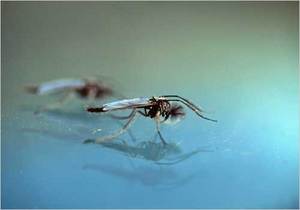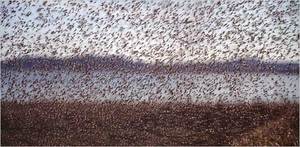Myvatn, translating from Icelandic to English, means Midge Lake.
Midges, baseball fans recall, are the gnat-like insects that rose from Lake Erie last October and descended upon Chamberlain in the bottom of the eighth inning of a playoff game against the Cleveland Indians, distracting him into throwing two wild pitches. Cleveland scored the tying run without a hit. The Yankees eventually lost the game and eventually the series.

|
| ©Arni Einarsson |
| A Lake Myvatn midge. |
During mating season, the air at Lake Myvatn can also be thick with male midges, each hovering, waiting for a female to join him. "It's a like a fog, a brown dense fog that just rises around the lake," said Anthony R. Ives, a professor of zoology at the University of Wisconsin.
Yet at the same time in other years, hardly a midge was to be seen at the lake. This boom-and-bust cycle - the density of midges can rise or fall by a factor of a million within a few years - drew the interest of ecologists like Dr. Ives.
In the current issue of the journal Nature, Dr. Ives and colleagues report that the population fluctuations depend largely on the abundance of hard-shelled algae known as diatoms, which the midges feed on, and that the complex dynamics can be captured within a simple equation.
The equation also suggests a fragility of nature - how a small, seemingly harmless action can ripple through the ecosystem and lead to unforeseen disruptions.
Ecologists have long played with mathematical models, trying to understand the dynamics of different animals. A simple example is a predator-prey model of foxes and rabbits. When rabbits multiply, foxes have abundant food and grow in population, too. But when the foxes have eaten too many rabbits, they run out of food and starve.
Similarly, an exploding midge population collapses when diatoms become scarce. Midge larvae, burrowed in the lake sediment, feed on diatoms that float by. When the larvae squeeze into every nook of sediment, diatoms have no room left to grow. "It's basically the midges eat themselves out of house and home," Dr. Ives said.
The diatoms can grow in rocky portions of the lake where the midge larvae cannot burrow, and after the midge population crashes, the diatoms eventually float back to the now midge-less sediments and the cycle begins anew.
Other times, the midge population remains roughly constant for years before resuming the boom-and-bust cycle. Two of Dr. Ives's co-authors, Arni Einarsson and Arnthor Gardarsson, have gathered data on the population of adult midges at Lake Myvatn since 1977. The fourth author of the Nature paper is Vincent A. A. Jansen of Royal Holloway, University of London.
Alan Hastings, a professor of environmental science and policy at the University of California, Davis, who was not involved in the research, said the paper "represents a real advance in getting that connection" between a mathematical model and an observed ecological system.

|
| ©Arni Einarsson |
| Mating swarms of male midges waiting for females around the shore of Lake Myvatn. |
The equation shows that both types of dynamics - a constant population and repeated boom-and-busts - are stable and will continue indefinitely if undisturbed. But natural systems are often disturbed by nature, like an unusually hot summer, or by people.
In the case of Lake Myvatn, a mining operation was started in 1967, scooping out part of the lake bottom for diatomite, a chalky white rock made of diatom shells and used for, among other purposes, filtering beer.
Less than two decades later, the fish population, which had provided food for people around the lake for a millennium, collapsed.
"There's always been a suspicion the two were linked, but people couldn't figure out what that link was," Dr. Ives said.
The new research suggests that the diatoms might have accumulated in the dredged depression, instead of floating to the shallower sediments, and that thus the midge populations took longer to recover from a population crash than in the past. With a dearth of midges, the fish that ate them also starved, and the fishery collapsed.
The mathematical model does not prove the link, "but at least it shows a mechanism that makes it seem possible," Dr. Ives said.
The diatomite dredging stopped in 2004, but the fish have not recovered. It is possible that life in the lake has settled on some new dynamics and that the fish will never return in abundance.
"Ecological systems are very complex this way," Dr. Hastings said. Such mathematical models may help biologists deduce culprits of change, he continued, adding, "It also suggests that caution is really, really important."
So the Yankees should think carefully before dredging Lake Erie to improve their World Series chances.



Reader Comments
to our Newsletter